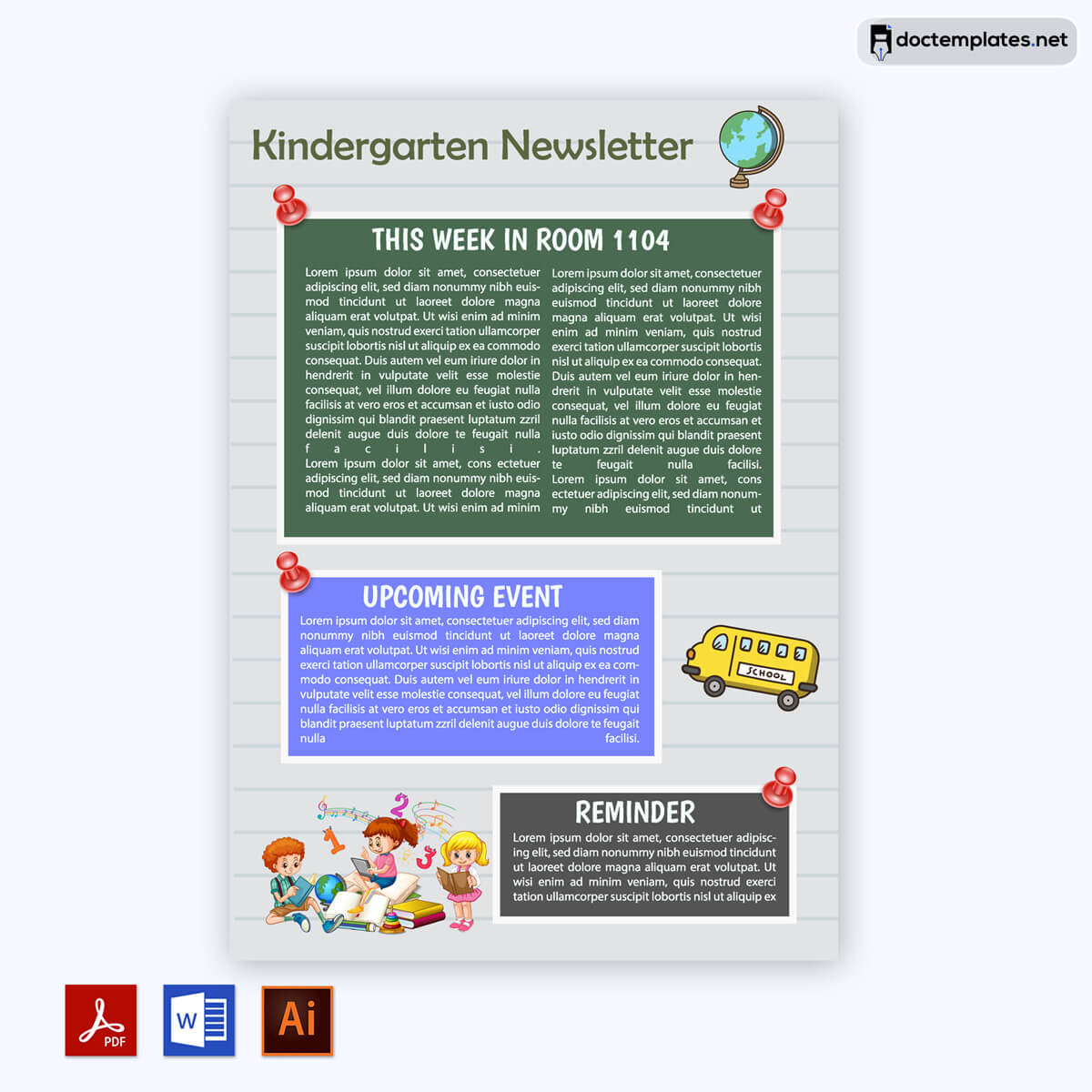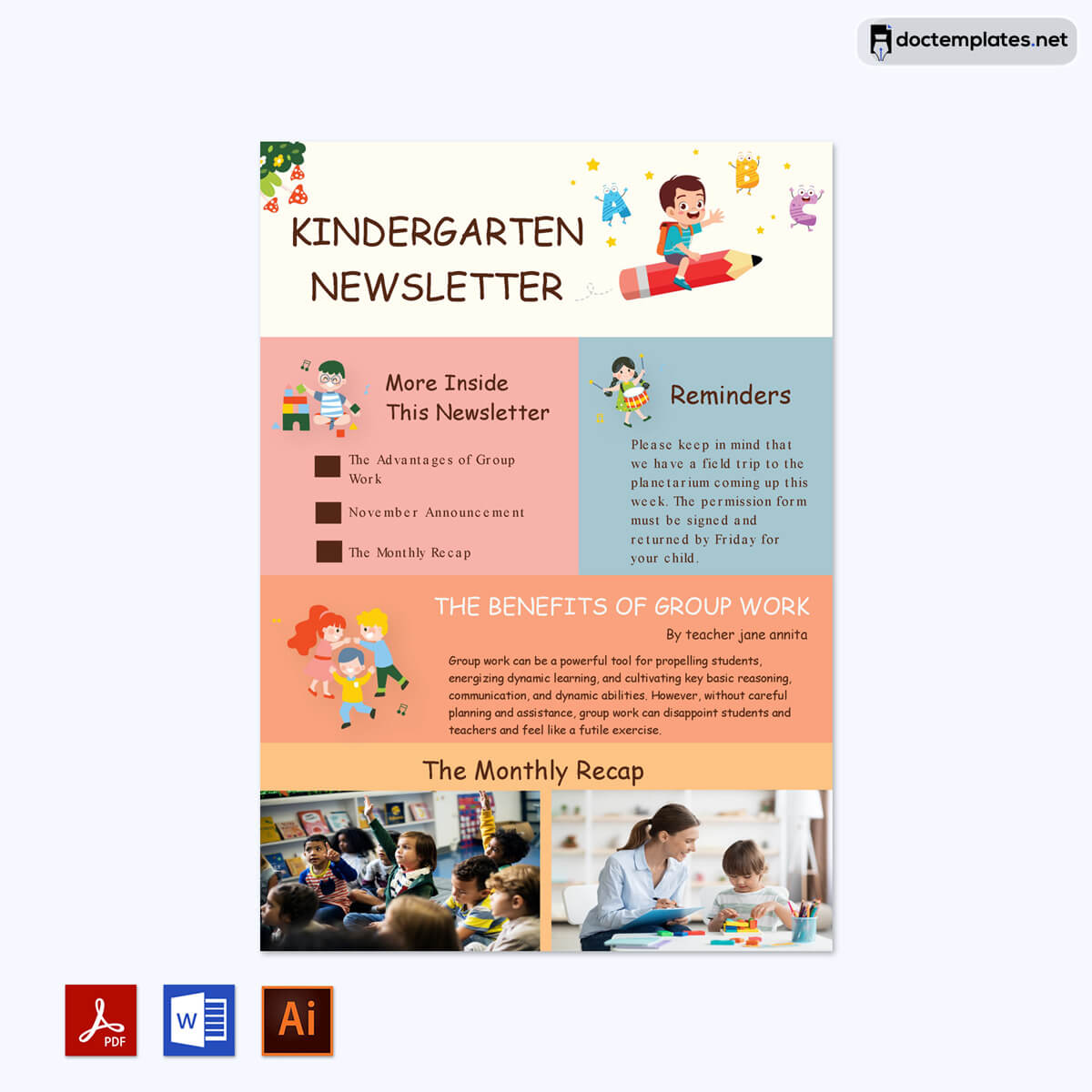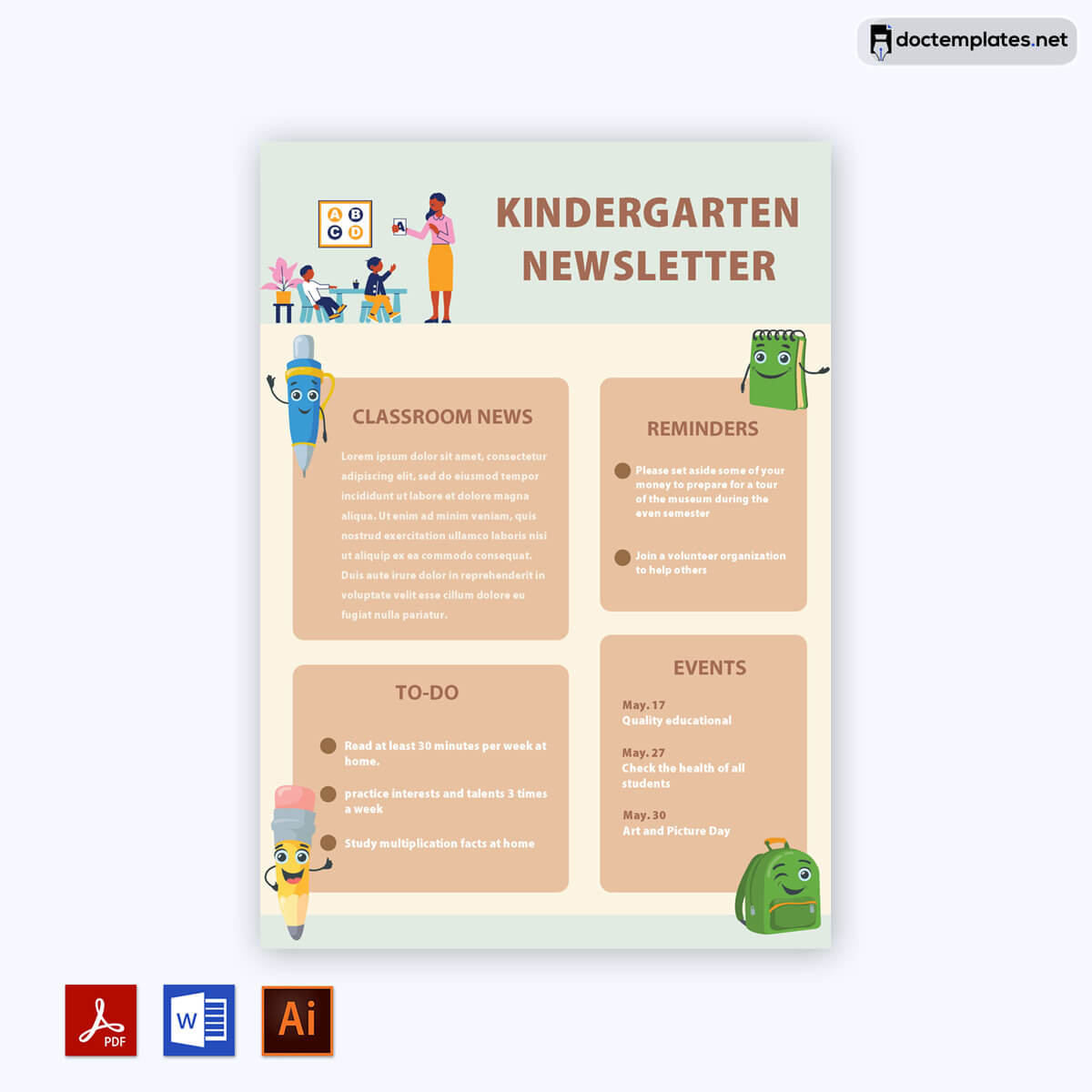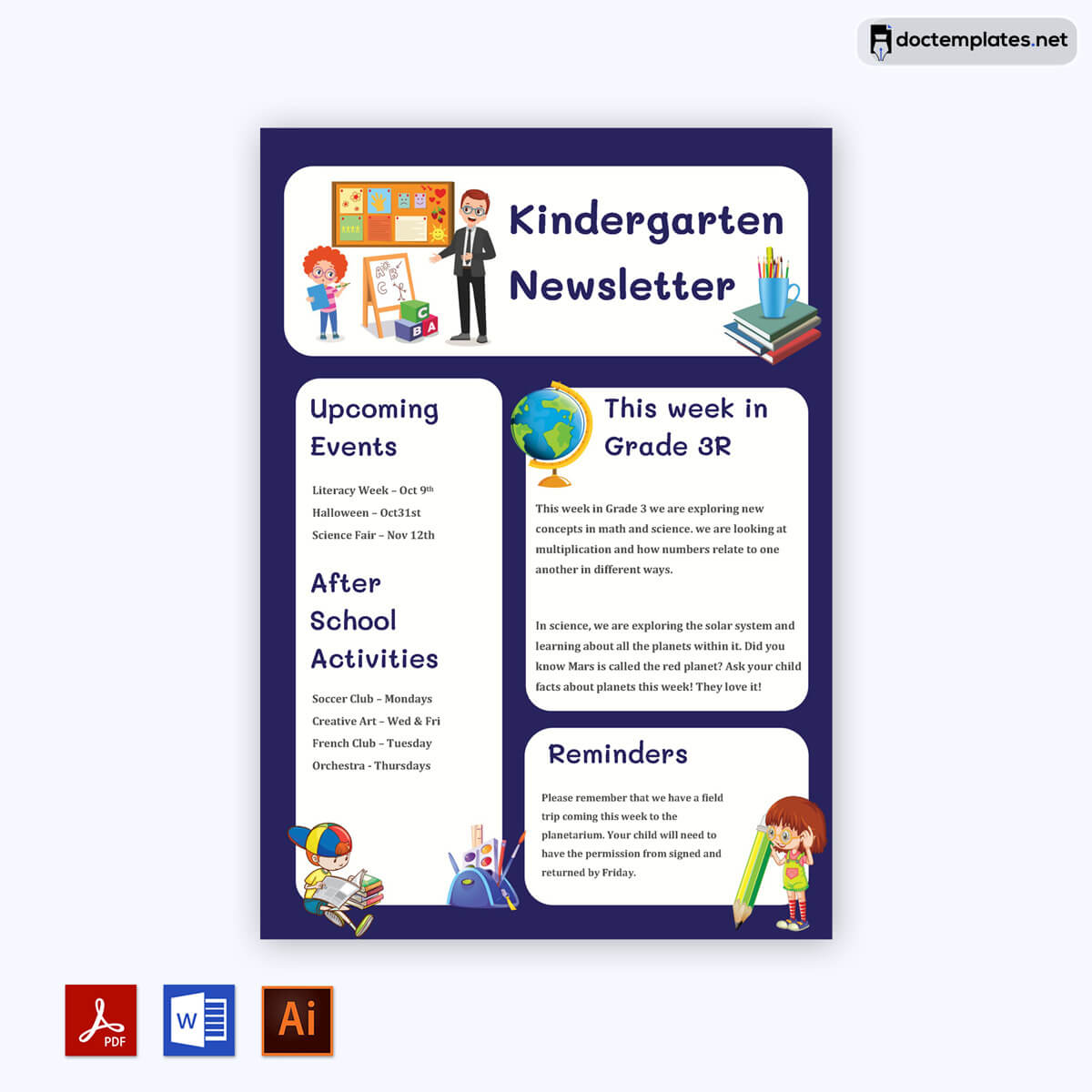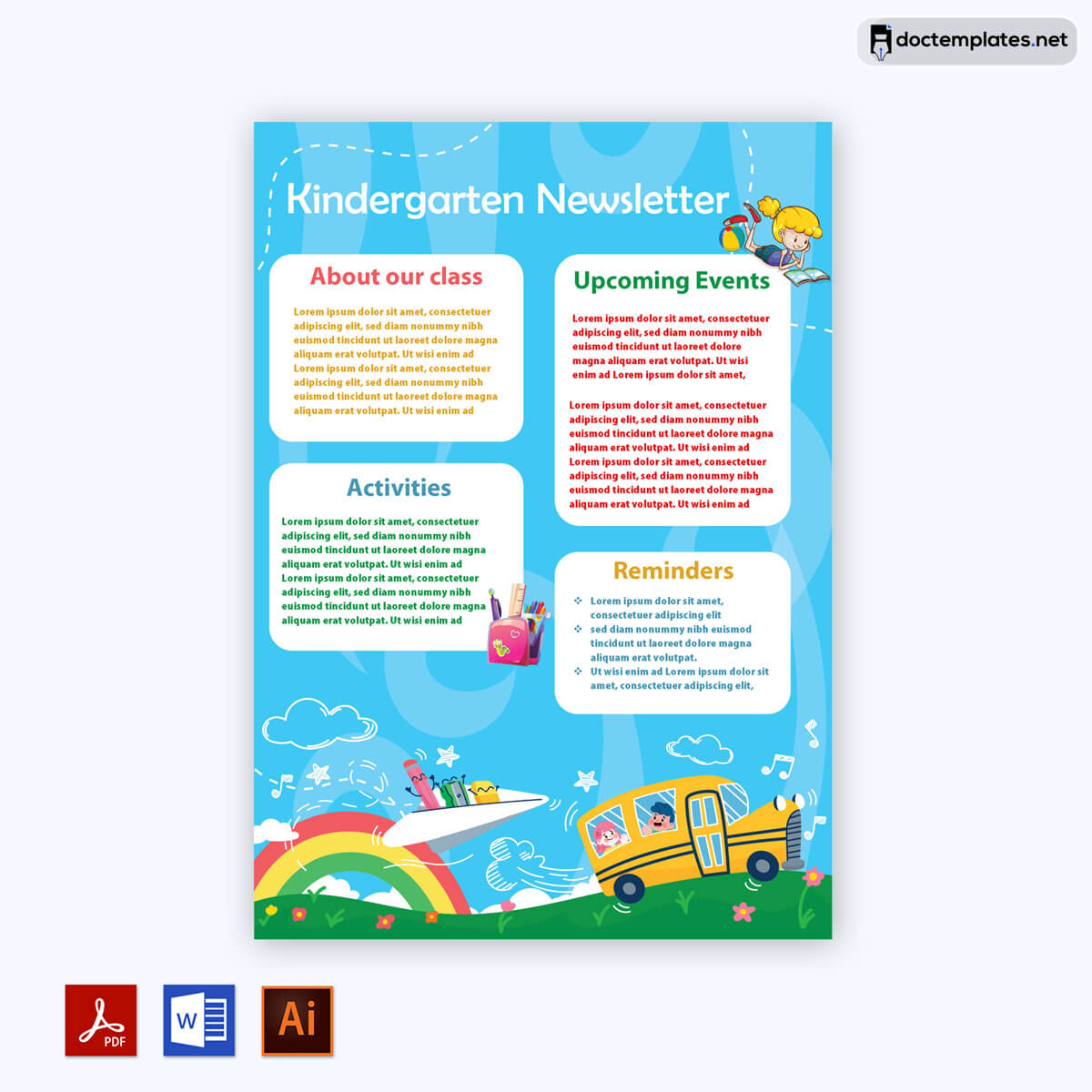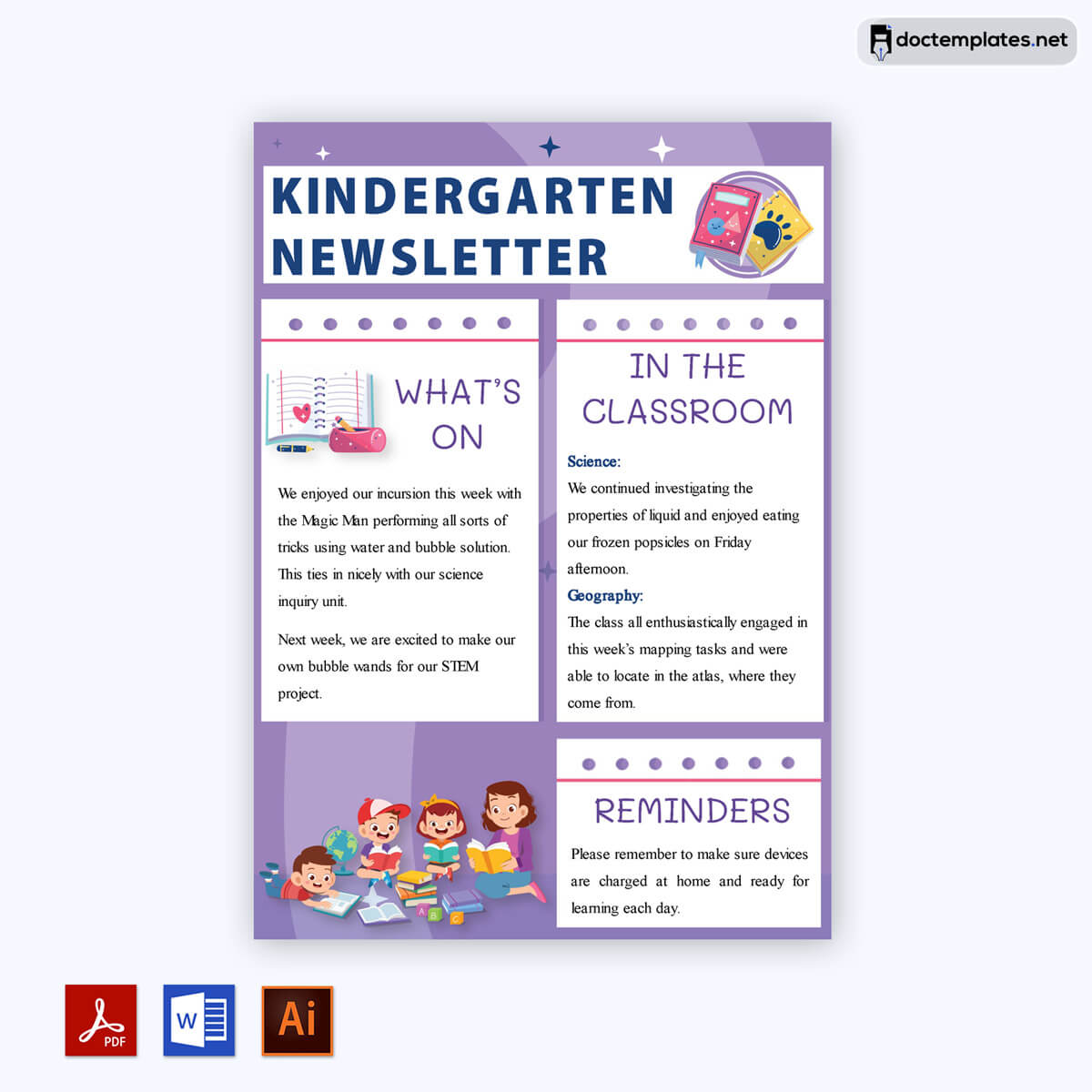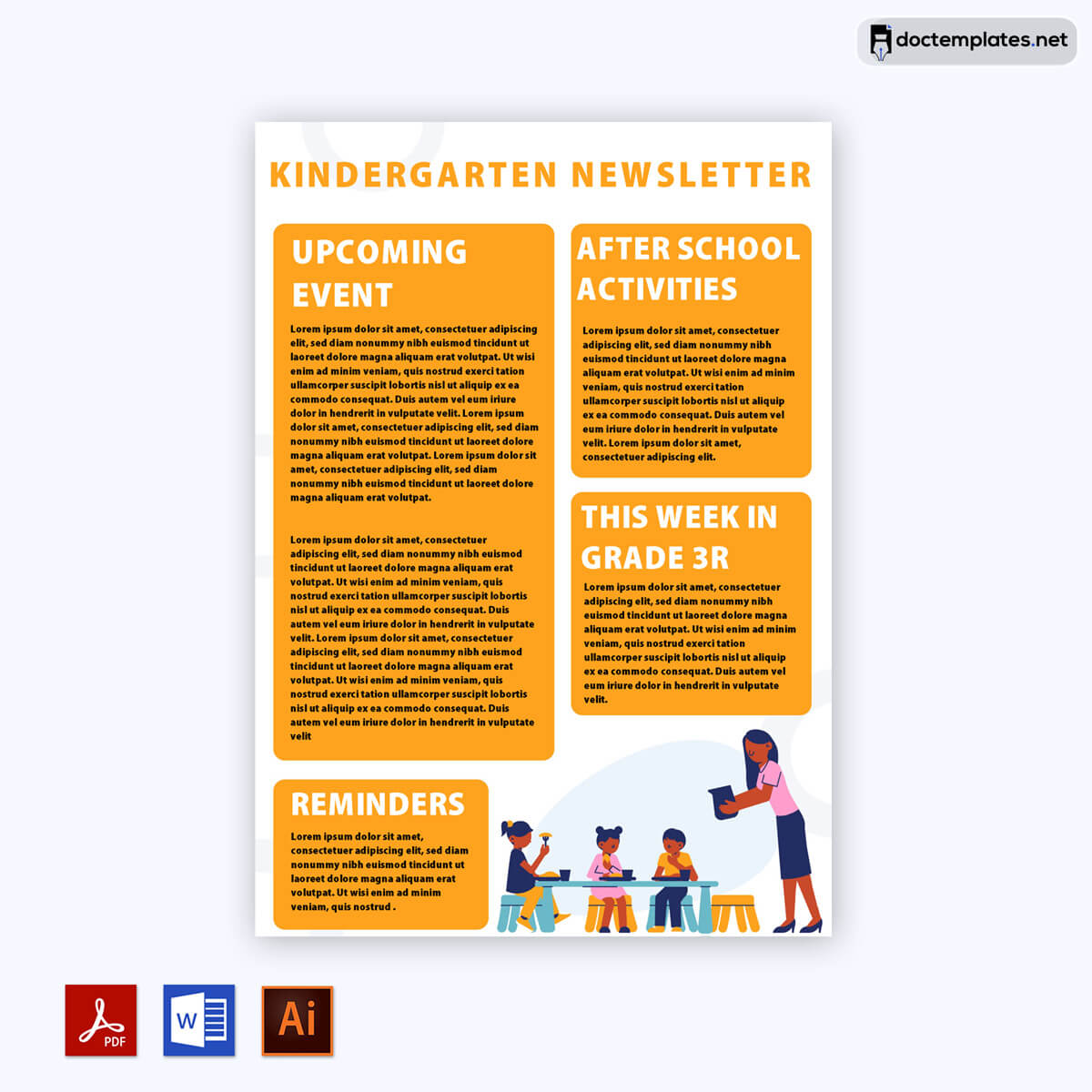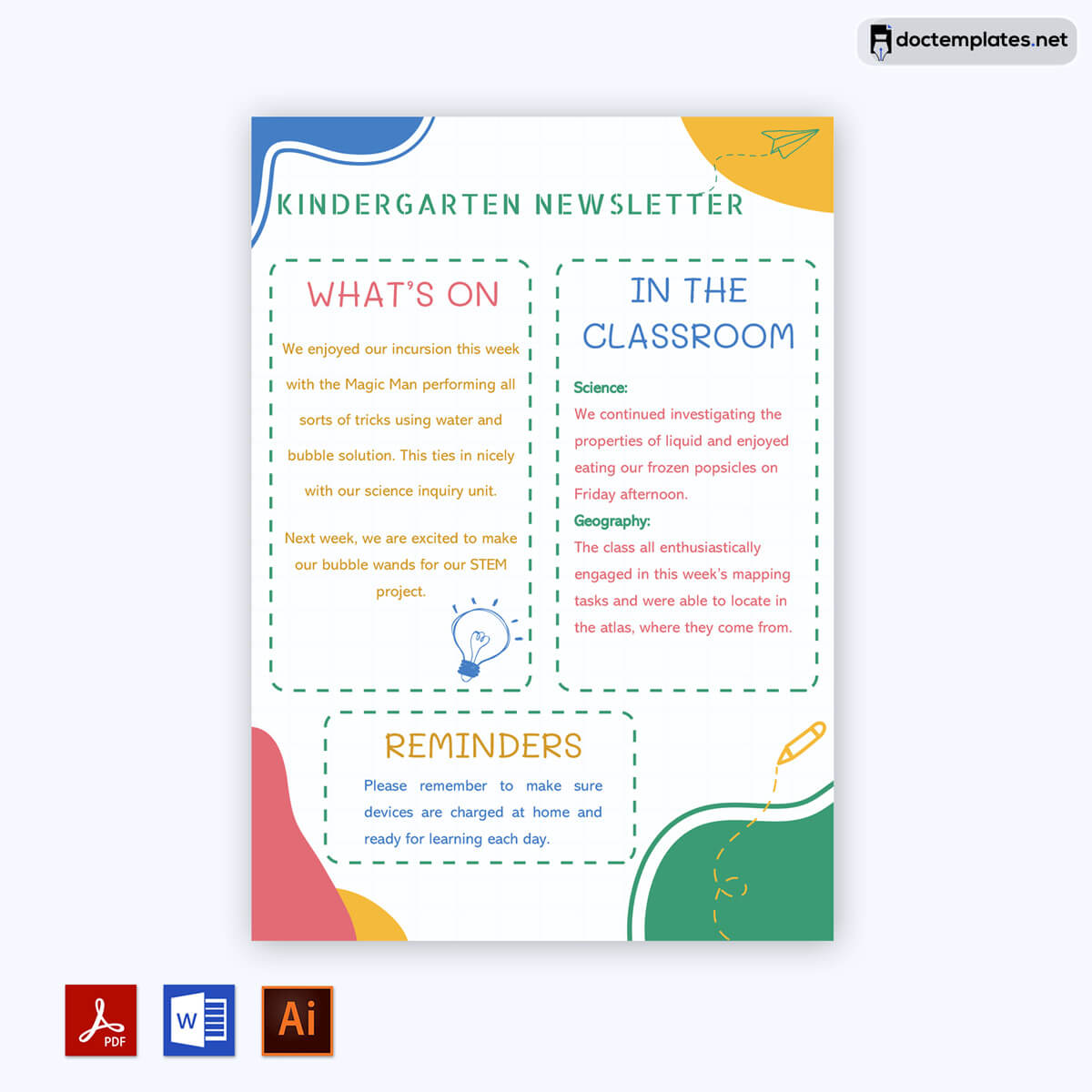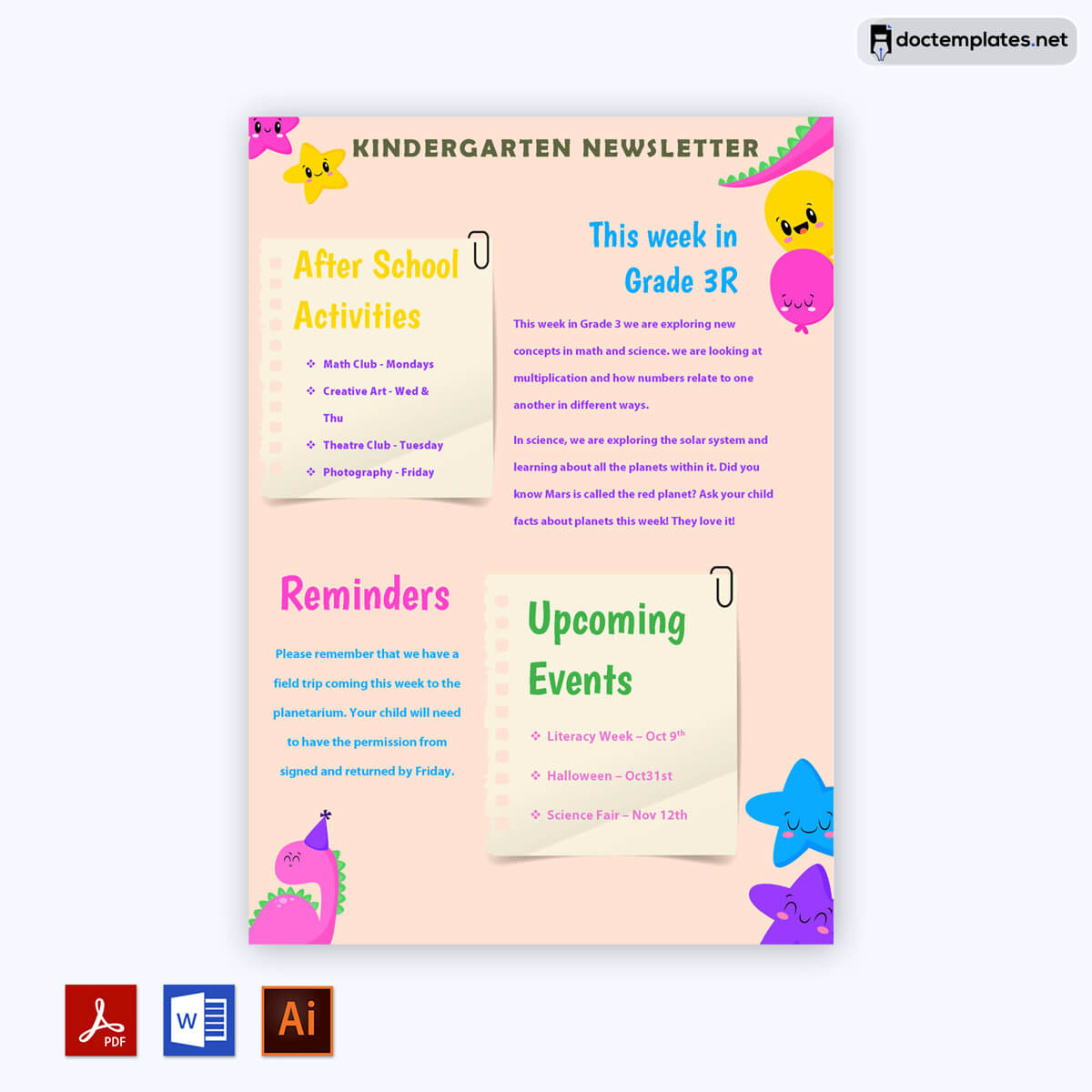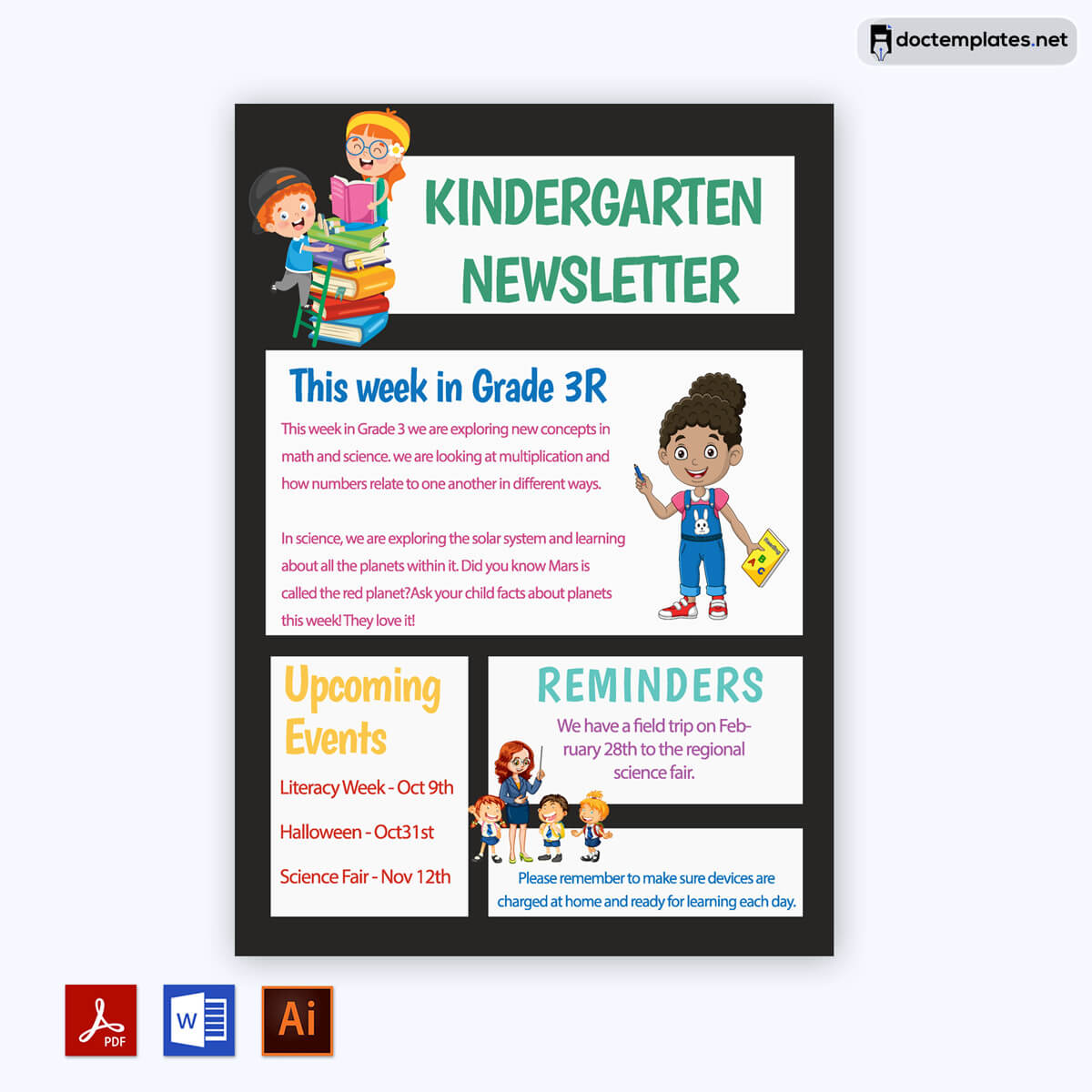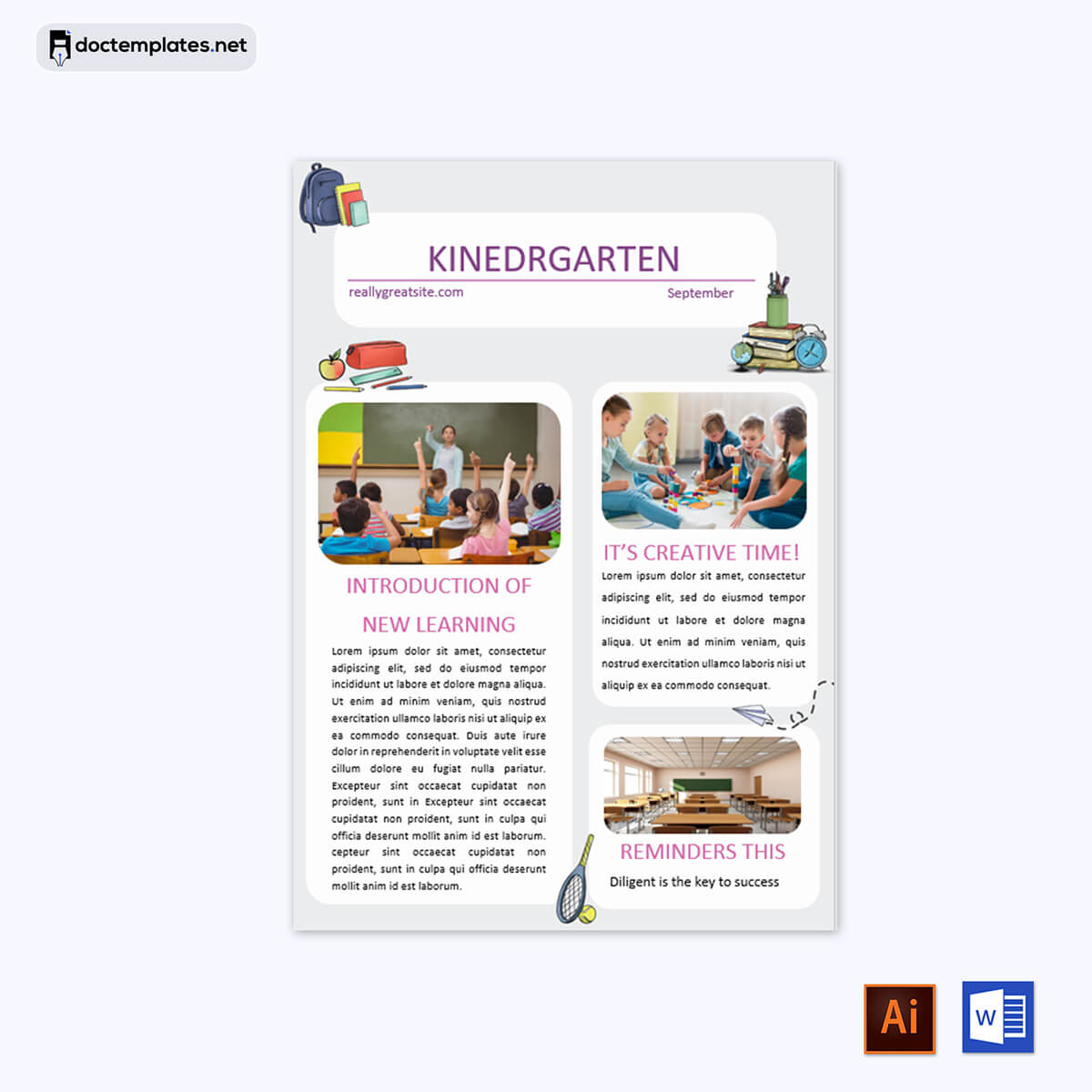A kindergarten newsletter is a document used by teachers and other school executives to communicate directly with the parents or guardians of the students.
Normally, the newsletter is sent at the end of every semester or on a more frequent basis. The information in the newsletter is purposed to enlighten the parents about their children’s academic progress.
Notably, as an educator, it is your responsibility to ensure that parents are aware of every activity their children are undertaking while at school. Therefore, you can use the kindergarten newsletter to inform and update parents about any upcoming events, make important announcements, and stay in contact with the parents regarding their children’s overall performances.
Free Templates
Given below are kindergarten newsletter templates:
Why is a Kindergarten Newsletter Important?
The newsletter is an essential communication channel between you and the parents. Apart from keeping the parents updated about different school activities, parents can also use the newsletter to learn more about their children’s academic development. Newsletters allow parents to participate actively in their children’s school activities like orientation, trips, and fundraising events. Therefore, the newsletter you prepare should be engaging and informative.
Furthermore, a well-prepared newsletter will allow parents to understand what their children are learning. This will ensure that they help you by taking charge of their children’s learning process at home. You can use the newsletter to inform parents of any important administrative changes. When parents have a clear idea of what is happening in their child’s classroom, they can offer useful feedback regarding your teaching program and other learning activities.
Steps Involved in a Kindergarten Newsletter Preparation
A newsletter is an important document to have as an educator. The newsletter should be prepared based on the learning activities undertaken at school while adhering to different school policies.
Here are steps you should consider when preparing a kindergarten newsletter:
Choose a template
Creating a newsletter for your classroom can be challenging, especially if it is your first time. However, with the help of a kindergarten newsletter template, you can create a perfect newsletter effortlessly. You can access our templates on our website for free. These newsletter templates will enable you to include all the important information when preparing the newsletter.
There are different templates that you can choose from below when you want to create a newsletter for your classroom. These templates can be downloaded and customized to suit your newsletter requirements. With a kindergarten newsletter template in place, updating your document will be easier and even save time.
Design the logo and front page
Your newsletter should be attractive at first glance. Therefore, the front page of the newsletter should be colorful and engaging. The design and the color of the newsletter should complement the content contained in the document. Also, if the newsletter is for announcing an upcoming event, then the colors on the front page should be the ones to be used in the event.
Also, you can add a logo to the front page. The logo will give the document identity and make it more appealing. You can use the school logo or design a classroom logo if needed. Additionally, you can add colorful images to the front page to improve the meaning of the message you are trying to communicate. Note that it is not necessary to include the logo on the inner pages of the document.
In case you are preparing a multi-page newsletter, ensure that you include a table of content to make it easier for the parents and other readers to access the information they need. You can refer to the table of contents as ‘What’s New’ or ‘In This Issue.’ Ensure that you clearly highlight the content of the newsletter and indicate the appropriate page numbers on the side.
Design the inside pages
The inside pages of the newsletter should clearly depict the message you are trying to communicate. Therefore, the selected design and the overall layout for your inner pages will be determined by the information you want to include in your newsletter. Note that your content should have a perfect balance between text, pictures, and illustrations.
If you are announcing and updating parents on upcoming events, you can include several pictures and illustrations because this content will require a few words. On the other hand, less room will be available for pictures and illustrations if you are writing an article for the newsletter.
Plan the content
The information in the newsletter will be determined with activities you plan to undertake during the semester. Also, those actively participating in these activities will determine the newsletter content. Therefore, you can plan your content to fit your daily, weekly, or monthly learning activities. In addition, when planning your content, you can take suggestions from the parents, the students, and other faculty members. As a result, you will be able to satisfy the demands of everyone.
Some of the content you can plan to include in your kindergarten newsletter include the following:
- Include important events: It is crucial to have a section in the newsletter where you have listed all the important dates; this makes it easier for the parents to identify the section and know when to attend all the important occasions. Ensure that you include other necessary details about these events, like the theme, location, attendance time, and what to bring. While attending these events, parents get a chance to interact with teachers and other parents; this allows you to share details about the academic progress of their children.
- Provide opportunities to volunteer: Most parents always look for ways to contribute to their children’s academic development directly. Therefore, you can provide information in the newsletter on how parents can voluntarily participate in different activities like assisting in organizing events, attending class meetings, or offering resources for class projects. With a chance to volunteer, parents will feel obliged to attend and actively participate in their children’s academic life.
- Explain school policies: This section is essential as it allows you to inform parents about the current school policies. Also, this section allows parents to learn of any new policies or changes made to existing policies.
- Include self-help content: Self-help information is essential as it enables parents to know how to help their children develop outside the classroom. The self-help content may include participating in activities that will improve the student’s mental, cognitive, social, emotional, and physical abilities. This content comes in handy whenever a parent wants to impact their child’s development at home. Therefore, in this section, you can suggest to parents different ways they can improve their children’s reading and learning abilities, ways to manage their behaviors, nutritional tips for their children, and how to make them love school.
- Include interviews, videos, and pictures: In the newsletter, you can include interviews that you have conducted with students and other teachers. You can use the interviews to ask questions regarding classwork and find out the student’s favorite subjects, songs, or games. Additionally, in the newsletter, you can add pictures that you have taken with the students while participating in different classroom activities, such as painting. Furthermore, if the newsletter will be in electronic format, you can attach recorded videos of you and the students participating in several academic or outdoor activities like hiking or swimming.
- Share acts of kindness: A kindness corner allows the students to share and show how they participated in different acts of kindness. These acts of kindness may include sharing their food, helping a friend tie a shoe, or helping a sick friend. This creation will show parents that their children are sympathetic, kind, smart, and responsible.
- Include administrative updates: In this section, you can include all important administrative details and updates. This may include scholarship opportunities, changes in staff members, job opportunities, volunteering opportunities, and any other relevant updates that directly affect the students or parents.
- Provide links to further reading: You can provide additional links if you are sending the newsletter via email. The extra links can include any important information that does not fit in the context of the newsletter. The links can contain details on any important projects the school is working on. Also, the links can provide extra information regarding a child’s unique interests and developments that a parent can follow up on and support while at home. Furthermore, you can use these links to share any insights on how parents can further help their children develop mentally, physically, and emotionally. You can do this by suggesting nutrition plans and extra reading and learning tips that parents can implement at home.
- Select a medium to distribute: Once the newsletter is complete, you can select a suitable distribution channel that will ensure these documents reach the target audience. You can use a soft copy and send the newsletter via email; this method is rapidly gaining popularity. Also, you can give the students a copy of the newsletter to take home and give to their parents. If you have the parents’ home addresses, you can send the newsletter to them via mail. Note that there is no distribution channel that is right or wrong. But you need to use a medium that is convenient for the parents.
Effective Practices to Write a Kindergarten Newsletter
As an educator, there are practices that you can adopt to help you write a proper and detailed kindergarten newsletter. Some of these effective practices include the following:
Determine newsletter frequency
Ensure that you establish and commit to a schedule of how frequently you will be publishing the newsletter. This way, the parents and children will know when to expect it. Also, producing the newsletter frequently means that the parents are always updated and informed about any changes, events, or news regarding the school.
Build a community
Ensure that you build and foster a community with the families of students. You can achieve this by introducing the community in the newsletter. Keep in mind that the students interact at school and become friends while their parents start forming bonds and creating a larger community than just the school. These resources include welcoming new families, sharing information about community events, including social media links, inviting parents to review your school activities, and even advertising all upcoming tours.
Connect kids and parents
As an educator, it is important to encourage parents to spend time with their kids after school. You can provide resources to facilitate these bonds, such as including photos of what their kids like doing, suggesting home activities, and including helpful resources for parents and kids.
Provide easy-to-read content
Ensure that the content you include in your document is easy to read, enticing and presentable. You can make the newsletter appealing by including photos and video clips with captions that provide an explanation of the highlighted events. Apart from photos, ensure that you also use bold and colorful headings, bullet points, and highlighted text. This will make it easier for parents and their kindergarten kids to skim through the newsletter.
Get the children involved
When creating the newsletter, it is advisable to involve the children. Ask them about their activities, values, and interests. Also, try and include their quotes, drawings, projects, videos, and artwork in the newsletter.
In addition, the newsletter should focus on children’s play as this is how they learn. By involving the children, you will make it easier for parents to understand how their children’s play contributes to their learning. You can also involve them in designing the layout and in the production process.
Keep it exclusive
Ensure that you keep the newsletter exclusive by sharing school details with parents through the newsletter before sharing the information elsewhere. Also, you can include unique offers for parents.
Optimize for mobile
With the use of technology, ensure that you make your newsletter digital and optimize it for mobiles. Parents would prefer reviewing the content on their smartphones, through emails, or via tablets. Ensure that the format you use is readable on mobile screens.
Make a personal connection
Your kindergarten newsletter should create a personal connection between you and the parents. You can do this by including a personal note for the parents, being open to feedback, and sharing little details about what they should expect in the next newsletter. This makes it easier for parents to contact you as they feel involved and part of the school community.
Make your reminders and requests count
Ensure that your newsletter includes a ‘reminders and requests’ section. This section should be straight to the point and respectful. It is meant to remind the parents about their kids’ activities, important event dates, late fees, administration requirements, and requests concerning a new policy. Make this section brief but easy to understand by using bullet points.
Keep it regular
Try and make your newsletter production as regular as possible. This gives the parents, their children, and your fellow educators something to look forward to. However, ensure that you choose a regular schedule that you can keep up with to avoid disappointing your audience. Ensure that you inform your staff about the distribution deadline. Also, you can ask the parents how regularly they would prefer their newsletters to make it easier for you.
Ask parents for feedback.
In your kindergarten newsletter, it is advisable to request feedback from the parents. You can ask them to suggest improvements to the newsletter and mention any activities, information events, or projects they want to see more of. Another way of getting feedback is by asking them to write replies to your newsletter articles or include their expectations, such as the Letter to the Editor or Parent Voices section.
Proofread carefully
Finally, always proofread your content before publishing it or sending it to the parents. Ensure that you check for spelling, grammar, and punctuation mistakes. Your document must be accurate with no mistakes. You can ask a colleague to help you proofread the newsletter.
Frequently Asked questions
How often should you send the kindergarten newsletter?
You can send the kindergarten newsletter on a weekly, bi-weekly, or monthly basis. The frequency all matters with your kindergarten program and the information you want to share. However, ensure that you remain consistent with the frequency you choose.
Should you list the contact list in the kindergarten newsletter?
It is advisable to include a contact list in the newsletter. This way, parents will know who to contact if they have questions or concerns about the school or their children. For the contact list, ensure that you include a working phone number, email address, names of teachers, and the school’s address.
What are the main elements to include in a kindergarten newsletter?
In a kindergarten newsletter, the main elements to include are updates, contact details, and great visual appeals. The updates include the school policies, news, activities, upcoming events, and any schedule changes. The visual appeal may include art from the children, educational videos, photos, and even links to the school’s or any other relevant website.

